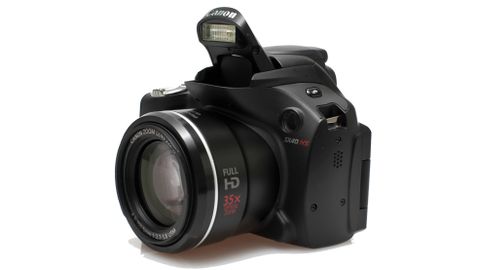Why you can trust TechRadar

The major changes to the SX40, from the previous SX30 model have been to improve the image quality, and it's something Canon has really worked on getting right.
The big new addition of course is the Digic 5 processor, which Canon claims reduces noise levels by up to 75% compared with previous models. We were of course very keen to test these claims out, and it's fair to say we were very impressed.
Noise levels remain very well controlled, even at the far end of the sensitivity settings. Images are usable throughout the range to ISO 1600, only beginning to drop off in quality at ISO 3200, but even these we found to be acceptable.
Digic 5 also allows for super fast shooting, with the option to shoot at 10.3fps for up to 8 frames at a time. Though it is impressive that the camera can achieve this, we find it's only really useable if you have a reasonable idea of where your subject is going to be within the frame, especially while shooting at the far reaches of the zoom range. This is because while shooting in this mode, as soon as you hit the shutter release, the camera will start taking images, shutting off the LCD screen or electronic viewfinder, meaning you can completely miss the action if you're framing is off a little.
Another new feature made possible by the Digic 5 processor is the new Multi Area White Balance. This new feature has the ability to detect different light sources, compensating for the differences between tungsten, flash and daylight for more realistic colours. In our tests, we were impressed with the white balance results.
It's a little disappointing that with all the advanced features the SX40 has, it's still not capable of shooting in raw format, however it's not surprising.
There is some evidence of chromatic aberration in areas of high contrast, but this is only really visible on very close inspection and shouldn't present much of a problem for everyday users.
Metering is good on the SX40, with the exposure system coping well with most situations, including high contrast scenes. On occasion, the camera tends to err on the side of underexposure, but exposure compensation can easily be accessed with the option to apply +/- 2EV in 1/3 EV steps available. A histogram can be displayed on the LCD screen, which is useful for keeping an eye on highlights and shadows.
Colours are reproduced well, coming out vibrant but generally not excessively punchy. A variety of scene modes are available, along with a few art filters. While we're not overly impressed with those that are on offer, Toy Camera, Fisheye and Miniature modes can be fun.
Current page: Performance
Prev Page Build quality and handling Next Page Image quality and resolutionAmy has been writing about cameras, photography and associated tech since 2009. Amy was once part of the photography testing team for Future Publishing working across TechRadar, Digital Camera, PhotoPlus, N Photo and Photography Week. For her photography, she has won awards and has been exhibited. She often partakes in unusual projects - including one intense year where she used a different camera every single day. Amy is currently the Features Editor at Amateur Photographer magazine, and in her increasingly little spare time works across a number of high-profile publications including Wired, Stuff, Digital Camera World, Expert Reviews, and just a little off-tangent, PetsRadar.

Inside the company making 35-year-old Game Boys look and work like new

AMD teams up with Arm to unveil AI chip family that does preprocessing, inference and postprocessing on one silicon — but you will have to wait more than 12 months to get actual products

The US takes another big step towards banning TikTok – here's what you need to know

